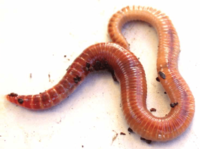Red wiggler worms: Difference between revisions
No edit summary |
No edit summary |
||
| Line 1: | Line 1: | ||
==Overview== | ==Overview== | ||
Red wiggler worms, scientifically known as '''''Eisenia fetida''''', are classified as ''[[Annelids]]''. They go by various other common names such as the manure worm, dung worm, tiger worm, etc. They are widely known for their use in [[compost]]<sup>[ | Red wiggler worms, scientifically known as '''''Eisenia fetida''''', are classified as ''[[Annelids]]''. They go by various other common names such as the manure worm, dung worm, tiger worm, etc. They are widely known for their use in [[compost]]<sup>[2]</sup>. | ||
---- | ---- | ||
==Classification== | ==Classification== | ||
[[File:Eisenia.png|200px|thumb|right|A red wiggler worm<sup>[ | [[File:Eisenia.png|200px|thumb|right|A red wiggler worm<sup>[1]</sup>]] | ||
'''Domain''': Eukarya | '''Domain''': Eukarya | ||
| Line 31: | Line 31: | ||
==Habitat== | ==Habitat== | ||
Red wiggler worms are [[Epigeic Earthworms ]], meaning they live on the upper surface of the soil or in the soil litter<sup>[ | Red wiggler worms are [[Epigeic Earthworms ]], meaning they live on the upper surface of the soil or in the soil litter<sup>[2]</sup>. Red wiggler worms prefer moist, organic-rich environments<sup>[3]</sup>. Manure or compost provides a great environment for them. The species originated from Europe, but because it is a commercial species and used as fish bait and in vermicomposting, it can be found all across the world<sup>[2]</sup>. | ||
==Life Cycle and Reproduction== | ==Life Cycle and Reproduction== | ||
==References== | ==References== | ||
[1] | [1]Eisenia andrei specimen during the experiment. Credit: photo courtesy... | Download Scientific Diagram. (n.d.). . https://www.researchgate.net/figure/Eisenia-andrei-specimen-during-the-experiment-Credit-photo-courtesy-of-Elaine-van-Ommen_fig1_265518697. | ||
[2] | [2]UWL Website. (n.d.). . http://bioweb.uwlax.edu/bio203/2010/yard_jose/habitat.htm. | ||
[3]Wormy FACTS and Interesting Tidbits (By Rhonda Sherman). (n.d.). . https://composting.ces.ncsu.edu/vermicomposting-2/wormy-facts-and-interesting-tidbits/. | |||
Revision as of 13:16, 25 April 2021
Overview
Red wiggler worms, scientifically known as Eisenia fetida, are classified as Annelids. They go by various other common names such as the manure worm, dung worm, tiger worm, etc. They are widely known for their use in compost[2].
Classification

Domain: Eukarya
Kingdom: Animalia
Phylum: Annelida
Class: Oligochaeta
Order: Hapliotaxida
Family: Lumbricidae
Genus: Eisenia
Species: Eisenia Fetida
Habitat
Red wiggler worms are Epigeic Earthworms , meaning they live on the upper surface of the soil or in the soil litter[2]. Red wiggler worms prefer moist, organic-rich environments[3]. Manure or compost provides a great environment for them. The species originated from Europe, but because it is a commercial species and used as fish bait and in vermicomposting, it can be found all across the world[2].
Life Cycle and Reproduction
References
[1]Eisenia andrei specimen during the experiment. Credit: photo courtesy... | Download Scientific Diagram. (n.d.). . https://www.researchgate.net/figure/Eisenia-andrei-specimen-during-the-experiment-Credit-photo-courtesy-of-Elaine-van-Ommen_fig1_265518697.
[2]UWL Website. (n.d.). . http://bioweb.uwlax.edu/bio203/2010/yard_jose/habitat.htm.
[3]Wormy FACTS and Interesting Tidbits (By Rhonda Sherman). (n.d.). . https://composting.ces.ncsu.edu/vermicomposting-2/wormy-facts-and-interesting-tidbits/.